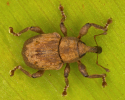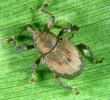Neochetina bruci Hustache |
||
| Order: Coleoptera Family: Curculionidae | ||
| Common name / Category: Weed insect of water hyacinthEichhornia crassipes | ||
Adults of Neochetina eichhorniae and Neochetina bruchi though look similar can be distinguished by the colour and the pattern of the scales covering elytra. N. bruchi is slightly larger in size and ranges in colour from brown with a broad crescent-shaped or chevron like tan band across the elytra to uniform tan or brown with no distinct markings. Neochetina eichhorniae never has the tan band and is usually grey mottled with brown. Both species have two short shiny, dark lines on the elytra, one on either side of the mid-line. In case of Neochetina eichhorniae the lines are usually situated farther forward, in front of mid-length but in N. bruchi the lines are situated very near mid-length. |
||
The sexes of both species can be separated by the attachment of antennae to the rostrum. In the case of males, the antennae are inserted at the distance from the apex of the rostrum, equal to or less than width of the rostrum at the point of insertion. In females, the antennae are inserted at a distance from the apex of the rostrum, more than the greatest width of the rostrum. |
||
Adults of Neochetina eichhorniae and Neochetina bruchi feed on leaves and deposit their eggs below epidermis of the petioles and laminae. Eggs are whitish and about 3-4 mm in length. The egg period of N. eichhorniae is 7-14 days and that of N. bruchi 6-10 days. Larvae are white or cream-coloured with a yellow-orange head. They have no legs or prolegs, only enlarged swellings with setae in place of legs. Larval and pupal periods of N. eichhorniae and N. bruchi are completed in 75-90 and 30-70 days, and 14-20 and 14-20 days respectively. |
||
Fecundity of N. eichhorniae and N. bruchi is 891 (150-1254) and 681.6 (313-918) respectively and adults live for 142 (32 - 207) and 134 (59-175) days, respectively. The mean egg production is 4.5 eggs per day. The peak egg laying is observed during 2nd to 5th weeks. |
||
Under glass house conditions 10 pairs of adults and their larval progeny per 0.58 m2 area reduced plant growth within one insect generation. However under field conditions 14 months to 6 years are required for obtaining significant levels of control. |
||
Ninety five per cent control in 20 ha tank in Bangalore by N. eichhorniae and 90% control of another 20 ha tank by N. bruchi has been achieved within 2-3 years of release. Due to regrowth of water hyacinth it may appear that the weevils are very slow in action. But once released in the water body, the gradual reduction in the petiole diameter and leaf density of floating plants and petiole length and plant density of rooted stands becomes evident, the flowering and seed production is also considerably reduced. |
||
| Production procedure | ||
Neochetina eichhorniae and Neochetina bruchi are multiplied on water hyacinth plants in outdoor tanks (4m2 x l m depth) cement cisterns or plastic fishing pools (120 cm dia x 60 cm depth). Addition of cowdung (200g/m3) and superphosphate 40g/m3 and urea 10g/m3 helps in improving the growth of water hyacinth plants leading to faster and prolific multiplication of the weevils. |
||
To start with plants are exposed inside the laboratory by keeping about 25 plants in 61x 40 x 30 cm plastic throughs and releasing 50 adults. After a week the adults are collected and used for exposing fresh plants. The exposed plants are kept outside either in tank or plastic fishing pools. This process is repeated until the tanks/pools are filled up. Atleast 15 exposures can be done with the same set of adults. |
||
Once fresh adults start emerging, after 3-4 months, they can be collected at fortnightly interval for field release. However, eggs laid by the adults before collection produces further generations. The tanks can thus be used for continuous multiplication just by the addition of fresh plants as and when older plants start drying. Between 100-250 adults can be collected per month by using a 120 cm diameter and 60 cm deep plastic fishing pool which can accommodate upto 100 plants. |
||
|

